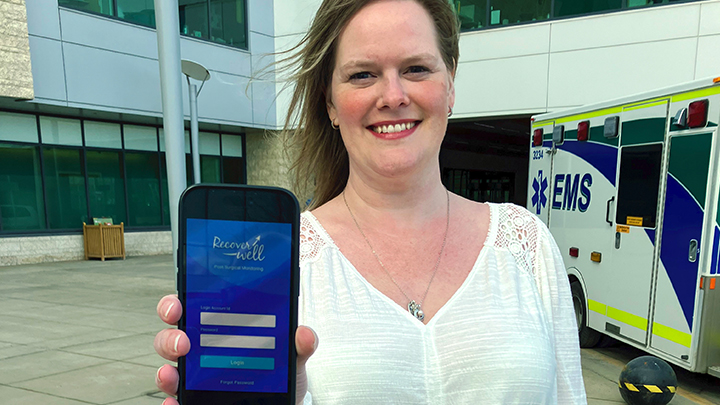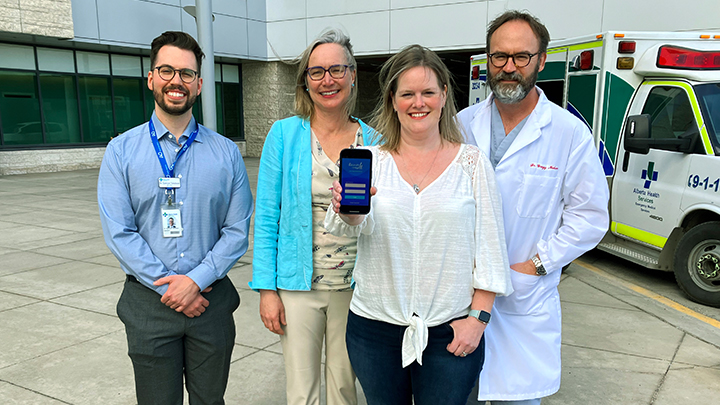
April 24, 2023

Madeleine Hamilton took part in a proof-of-concept study that evaluated a smartphone app for post-operative recovery. Photo by Greg Harris.

Madeleine Hamilton, third from left, is shown here with app researchers, from left, Drs. Spencer Yakaback, Claire Temple-Oberle and Gregg Nelson. Photo by Greg Harris.
Story & photos by Greg Harris
CALGARY — Madeleine Hamilton suspected something was amiss during her recovery from breast reconstruction surgery about three days after the procedure.
“I consider myself pretty tough when it comes to post-operative pain, but I felt like I was just getting worse instead of better,” says Hamilton, who has also had a double mastectomy and other surgeries. “I felt out of breath and like something wasn’t right. The pain was increasing and I felt pretty terrible.”
Because Hamilton was taking part in a research study testing the safety and effectiveness of a smartphone app designed to aid surgical recovery, she was able to send messages and photos to her care team, which included her surgeon, Dr. Claire Temple-Oberle.
Photos of her incision sites appeared normal, but Hamilton’s responses to a series of questions about her recovery caused concern. Dr. Temple-Oberle advised Hamilton to come back to her clinic at Foothills Medical Centre for more evaluation. A CT scan subsequently showed Hamilton had a pulmonary embolism.
“That app — and Claire — potentially saved my life,” says Hamilton. About a third of untreated pulmonary embolisms are fatal, something Hamilton is well aware of as a registered nurse.
Now, the prestigious academic journal JAMA Surgery has published the encouraging results of the study. Although the smartphone app is not currently being used in AHS outside this evaluation context, researchers say apps like it could one day become valuable additions to post-operative care.
“Surgeons liked the app, and patients felt well-connected when using it,” says Temple-Oberle, who conceived of the study and was its principal investigator. “The results add to a growing body of evidence that shows apps like these can support patients recovering at home — without compromising safety.”
The study focused on patients having breast reconstruction or gynecologic oncology surgeries that were performed according to Enhanced Recovery After Surgery (ERAS) guidelines.
ERAS guidelines consist of about 20 different practices before, during and after surgery. They include keeping patients well-nourished, giving them anti-coagulants and pre-operative antibiotics, avoiding cold in the operating room, avoiding the use of long-acting sedatives, using non-opioid pain medications (where alternatives are medically appropriate), using anti-nauseants, and encouraging patients to move as soon as possible after surgery.
Dr. Gregg Nelson, a co-investigator on the study and a surgeon who helped introduce ERAS in Alberta in 2013, says ERAS patients are being discharged home sooner than anyone could have predicted.
“Better care happens to be faster care,” says Nelson. “When you have a supportive team around you it decreases your stress knowing you’re connected. Smartphone apps are further extensions of that supportive care team. It’s no surprise that we’ve had a lot of interest from other physicians about how well this app was received.”
AHS is currently focused on four priority areas, two of which are: reducing wait times for surgeries and improving patient flow throughout the healthcare continuum. ERAS guidelines, now used in Alberta across multiple surgical disciplines, help with both these priorities.
“I fully endorse the app,” adds Hamilton. “It had a huge impact on my recovery and played a big role in the diagnosis of my pulmonary embolism. At first, I thought it was just an extra thing to do, but it was really comforting knowing my responses and results were being reviewed.”
Hamilton ultimately made a full recovery from the pulmonary embolism after treatment with blood thinners.
When she was 17, she was diagnosed with the cancer-causing BRCA2 gene. Several years ago, she had a double mastectomy as a preventative measure and has since had additional reconstructions.
This smartphone app research project was made possible thanks to the generosity of Alberta Cancer Foundation (ACF) donors.
“Innovations like these hold the promise of better supporting patients throughout their healthcare journeys,” says Wendy Beauchesne, ACF CEO.
“Rural patients could benefit from a recovery tool like this, and it would also help reduce travel and parking costs for everyone by reducing the number of return visits needed to hospital.”
Other researchers involved in the project include Dr. Spencer Yakaback, Carmen Webb and Golpira Elmi Assadzadeh. Drs Temple-Oberle and Nelson are on faculty at the Cumming School of Medicine at the University of Calgary and members of the Charbonneau Cancer Institute.
Effect of Smartphone App Postoperative Home Monitoring After Oncologic Surgery on Quality of Recovery: A Randomized Clinical Trial, appeared in the April 12 online edition of JAMA Surgery.